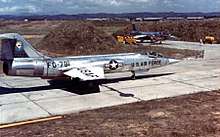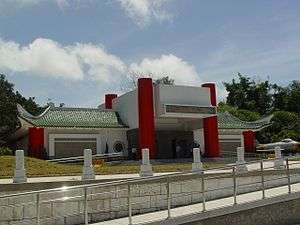Second Taiwan Strait Crisis
| Second Taiwan Strait Crisis | |||||||
|---|---|---|---|---|---|---|---|
| Part of the Cold War and Chinese Civil War | |||||||
 Taiwan Strait | |||||||
| |||||||
| Belligerents | |||||||
|
|
| ||||||
| Commanders and leaders | |||||||
|
|
| ||||||
| Strength | |||||||
|
|
| ||||||
| Casualties and losses | |||||||
| 440 ROC troops killed[1] | 460 PRC troops killed, 218 civilians killed. | ||||||
The Second Taiwan Strait Crisis, also called the 1958 Taiwan Strait Crisis, was a conflict that took place between the People's Republic of China (PRC) and the Republic of China (ROC) in which the PRC shelled the islands of Kinmen and the nearby Matsu Islands along the east coast of the PRC (in the Taiwan Strait) to "liberate" Taiwan from the Chinese Nationalist Party, also called Kuomintang (KMT), and probe the extent of the United States defense of Taiwan's territory.
Overview
The crisis started with the 823 Artillery Bombardment (Chinese: 八二三砲戰; pinyin: Bā'èrsān Pàozhàn; Pe̍h-ōe-jī: Pat-jī-sam Phàu-chiàn) at 5:30 pm on 23 August 1958, when the PRC's People's Liberation Army (PLA) began an intense artillery bombardment against Quemoy (Kinmen). The ROC troops on Kinmen dug in and then returned fire. In the heavy exchange of fire, roughly 440 ROC soldiers and 460 PRC soldiers were killed.[2]
This conflict was a continuation of the First Taiwan Strait Crisis, which had begun immediately after the Korean War ended. The Nationalist Chinese had begun to build on the island of Kinmen and the nearby Matsu archipelago. During 1954, the PLA began firing artillery at both Kinmen and some of the nearby Matsu islands.
The American Eisenhower Administration responded to the request for aid from the ROC according to its obligations in the mutual defense treaty that had been ratified in 1954. President Dwight D. Eisenhower ordered the reinforcement of the U.S. Navy Seventh Fleet in the area, and he ordered American naval vessels to help the Nationalist Chinese government to protect the supply lines to the islands. In addition, the U.S. Air Force deployed F-100D Super Sabres, F-101C Voodoos, F-104A Starfighters, and B-57B Canberras to Taiwan to demonstrate support for the republic. The F-104s were disassembled and airlifted to Taiwan in C-124 Globemaster II transport aircraft, the first time such a method was used to move fighter aircraft over a long distance.[3]

Also, under a secret effort called "Operation Black Magic", the U.S. Navy modified some of the F-86 Sabre fighters of the Nationalist Chinese Air Force with its newly developed AIM-9 Sidewinder air-to-air missiles (early models). These missiles gave the Nationalist Chinese pilots a decisive edge over the Soviet-made MiG-15 and MiG-17 fighters in the skies over the Matsu Islands and the Taiwan Strait. The Nationalist Chinese pilots used the Sidewinder missiles to score numerous kills on PLAAF MiG aircraft.
The US Army's contribution was to reinforce the strategic air defense capability of the Nationalist China. A provisional Nike battalion was organized at Fort Bliss, TX, and sent via USMTS USS General J. C. Breckinridge (AP-176) to Nationalist China. The 2nd Missile Battalion was augmented with detachments of signal, ordnance and engineers, totaling some 704 personnel.
Twelve long-range 203 mm (8-inch) M115 howitzer artillery pieces and numerous 155 mm howitzers were transferred from the U.S. Marine Corps to the Army of the Nationalist China. These were sent west to Kinmen Island to gain superiority in the artillery duel back and forth over the straits there. The impact of these powerful (but conventional) artillery pieces led some members of the PLA to believe that American artillerymen had begun to use nuclear weapons against them.
Soon, the Soviet Union dispatched its foreign minister, Andrei Gromyko, to Beijing to discuss the actions of the PLA and the Communist Chinese Air Force (PLAAF), with advice of caution to the Communist Chinese.
On 22 September 1958, the Sidewinder missile was used for the first time in air-to-air combat as 32 Nationalist Chinese F-86s clashed with 100 Communist Chinese (PLAAF) MiGs in a series of aerial engagements. Numerous MiGs were shot down by Sidewinders, the first "kills" to be scored by air-to-air missiles in combat.
Soon, the Communist China was faced with a stalemate, the PLA's artillerymen had run out of artillery shells. The Communist Chinese government announced a large decrease in bombardment levels on October 6.
Aftermath

Afterwards, both sides continued to bombard each other with shells containing propaganda leaflets on alternate days of the week. This strange informal arrangement continued until the normalization of diplomatic relations between the United States and the Communist China in 1979. The timed shelling eventually created little damage and casualties, it was mainly aimed at military compounds and artillery pieces. It was also a way to expend expired ammunition and train new artillery crews for the Communist China in what eventually became one-way shelling from Communist China to Nationalist China.
The question of "Matsu and Quemoy (Kinmen)" became an issue in the 1960 U.S. presidential election when Richard Nixon accused John F. Kennedy of being unwilling to commit to using nuclear weapons if the Communist China invaded the Nationalist China outposts.
The spent shell casings and fragments have become a recyclable resource for steel for the local economy. Since the Second Taiwan Strait Crisis, Kinmen has become famous for its production of meat cleavers made from bombshells.
See also
Further reading
- Bush, R. & O'Hanlon, M. (2007). A War Like No Other: The Truth About China's Challenge to America. Wiley. ISBN 0-471-98677-1
- Bush, R. (2006). Untying the Knot: Making Peace in the Taiwan Strait. Brookings Institution Press. ISBN 0-8157-1290-1
- Carpenter, T. (2006). America's Coming War with China: A Collision Course over Taiwan. Palgrave Macmillan. ISBN 1-4039-6841-1
- Cole, B. (2006). Taiwan's Security: History and Prospects. Routledge. ISBN 0-415-36581-3
- Copper, J. (2006). Playing with Fire: The Looming War with China over Taiwan. Praeger Security International General Interest. ISBN 0-275-98888-0
- Federation of American Scientists et al. (2006). Chinese Nuclear Forces and U.S. Nuclear War Planning
- Gill, B. (2007). Rising Star: China's New Security Diplomacy. Brookings Institution Press. ISBN 0-8157-3146-9
- Shirk, S. (2007). China: Fragile Superpower: How China's Internal Politics Could Derail Its Peaceful Rise. Oxford University Press. ISBN 0-19-530609-0
- Tsang, S. (2006). If China Attacks Taiwan: Military Strategy, Politics and Economics. Routledge. ISBN 0-415-40785-0
- Tucker, N.B. (2005). Dangerous Strait: the U.S.-Taiwan-China Crisis. Columbia University Press. ISBN 0-231-13564-5
- Watry, David M. Diplomacy at the Brink: Eisenhower, Churchill, and Eden in the Cold War. Baton Rouge: Louisiana State University Press, 2014.
References
Citations
- ↑ Maritime Taiwan: Historical Encounters with the East and the West by Shih-Shan Henry Tsai. Page 189. Published 2009
- ↑ https://books.google.com/books?id=-GtQcoqYi-4C&lpg=PA321&ots=yniC8_xI0u&dq=9094%E6%9E%B6%E6%AC%A1&hl=zh-TW&pg=PA324#v=onepage&q=9094%E6%9E%B6%E6%AC%A1&f=true
- ↑ Davies, Peter E. (2014). F-104 Starfighter Units in Combat. Great Britain: Osprey Publishing. pp. 22–23. ISBN 978-1-78096-313-6.
Sources
- Chen Jian. (2001). Mao's China and the Cold War - Beijing and the Taiwan Strait Crisis of 1958. The University of North Carolina Press.
- http://www.generals.dk/general/Qiu_Qing-quan/_/China.html
- Ministry of National Defense, R.O.C.
- US Naval War College
- https://web.archive.org/web/20090326011824/http://cgsc.leavenworth.army.mil/carl/download/csipubs/bjorge_huai.pdf
External links
- http://www.globalsecurity.org/military/ops/quemoy_matsu-2.htm
- Mao Zedong's handling of the Taiwan Straits Crisis of 1958
- Khrushchev's Nuclear Promise to Beijing During the 1958 Crisis
- First and Second Taiwan Strait Crisis, Quemoy and Matsu Islands of Taiwan from the Cold War Museum
- The Communist Threat in the Taiwan Area Contemparary US government reaction
- YouTube - Taiwan After WW2 | US Army & Republic of China Army Prepare for War with China | Documentary